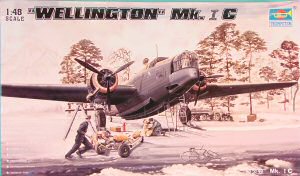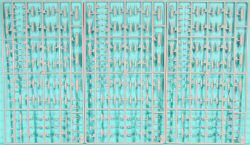
Trumpeter 1/48 Wellington Mk.IC Kit First Look
By Michael Benolkin
| Date of Review | August 2006 | Manufacturer | Trumpeter |
|---|---|---|---|
| Subject | Wellington Mk.IC | Scale | 1/48 |
| Kit Number | 2808 | Primary Media | Styrene, Photo-Etch, White Metal |
| Pros | Nice interior, bomb bay, & wheel wells; no photo-etched control hinges; positionable flight controls & flaps | Cons | Geodetic details on wing and tail surfaces slightly overdone |
| Skill Level | Intermediate | MSRP (USD) | $109.98 |
First Look
 |
 |
 |
 |
 |
 |
 |
 |
 |
 |
 |
In response to Air Ministry Specification B.9/32 calling for a medium day bomber, Vickers put forth a design in 1932 using a geodetic framework to create a robust aircraft without the weight penalty. This design had been previously used on the Wellesley single-engine bomber. The resulting Wellington would replace the RAF's biplane bombers with a capable monoplane bomber.
Despite being technically obsolete by the time the second world war rolled around, the Wellington not only served with distinction throughout the war, it also continued into civilian service after the war. Not only did the Wellington serve as a medium bomber in the early years of the war, it would also serve Coastal Command as a patrol aircraft, Training Command as a multi-engined trainer, and even work in the special mission worlds as well.
The Wellington Mk.IC was a minor update replacing the old electrical system for a 24 volt standard and adding a pair of Browning .303 guns to the defensive armament.
Trumpeter has released the long-awaited Vickers Wellington in 1/48 scale. As with previous releases from Trumpeter, this kit has lots of detail inside and out. The most noteworthy feature about the Wellington in full-scale is the geodetic construction. The lattice-type framework is very distinctive in every photo of the subject. This detail has been thoroughly captured in the kit. As with other aircraft of the era, the Wellington was fabric-covered. That means that under the right lighting conditions and at the right angles, you can see the underlying structure of the aircraft against the drum-tight fabric skin of the fuselage, wings, tail, and flight control surfaces.
Having explained all of that, some of you will remember how Trumpeter overdid the framework that was visible through the fabric skin of the SM.79 Sparviero just a bit. The good news is that the framework of the fuselage looks about right. On the other hand, the geodetic framework that is visible in the surfaces of the wings and tail is just a tad overdone. Depending on the paint scheme, you might want to subdue the visible geodetic framework. I don't believe you'll see much of this if you're painting the aircraft in RAF night schemes with the majority of the aircraft surfaces black and only the upper surfaces green/brown. If there is no gloss in the final finish, you shouldn't see much of that structure.
The kit is comprised of fourteen parts trees molded in light gray styrene and two parts trees molded in clear styrene. The kit has some great detailing molded throughout. There is one fret of photo-etched parts that are essentially the inner walls of the main wheel wells. An acetate sheet containing the printed instrument faces goes behind the clear instrument panel. In a first (for me), the kit features white metal landing gear struts for the main gear and the tailwheel. The wheel hubs are styrene, but the tires are rubber.
The kit features a detailed interior. Not just the cockpit, the whole interior. The main cabin floor doubles as the top of the bomb bay. This kit has a very nicely done bomb bay and cabin interior. In fact, you'll note that there are three trees of bombs providing one of the nicer array of early RAF bombs I've seen. There are 2000lb AP bombs, 1000lb GP bombs, 500lb GP bombs, 500 lb SAP bombs, 250lb SAP bombs, 250lb B bombs, and 250lb GP bombs included in the set. The instructions show seven different loadout options for your bomber.
As with previous Trumpeter releases, the Pegasus engines are super-detailed models of their own right. The kit provides your choice of open or closed cowl flaps, and if you opt to leave the flaps open, there will be plenty of detail inside to see.
In addition to the cowl flaps, you have positionable flight control surfaces, positionable landing flaps, and your choice of open or closed bomb bay doors. One detail that I had never noticed before is the sheer number of doors for the bomb bay! Thirty (30!) to be precise. Don't worry, if you opt to leave the bomb bay closed, there is a single part to cover that large opening.
Markings are included for two aircraft:
- Wellington Mk.IC, X9889, BL-D, 40 Sqn, Malta 1941
- Wellington Mk.IC, T2835, AA-C, 75 Sqn, RAF Norfolk, 1941
Aside from the somewhat exaggerated geodetic detail molded into the wing and tail surfaces, this looks like a nice kit with no serious build challenges in construction. As I said earlier, with a dark and dead flat finish, the geodetic pattern will look about right.
The addition of white metal for landing gear struts is an interesting change for Trumpeter. With all of the transparent areas in the airframe, you'll be able to show off your artistic skills inside and out of this beautiful kit.
My sincere thanks to Stevens International for this review sample!
Resources
- Vickers Wellington, Alan W. Hall, Warpaint Series No.10, Hall Park Books Ltd







